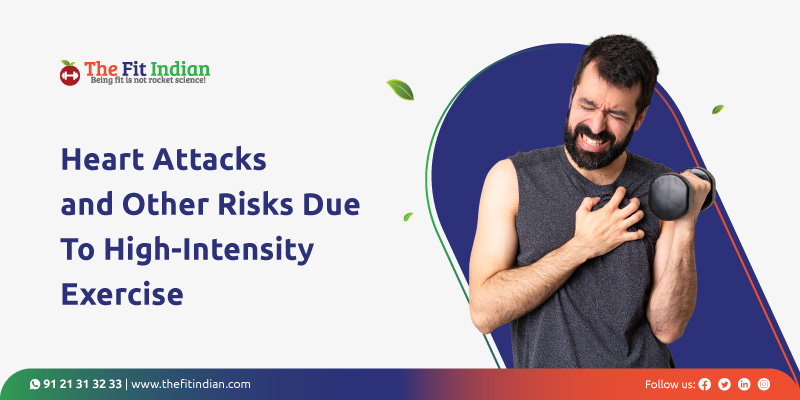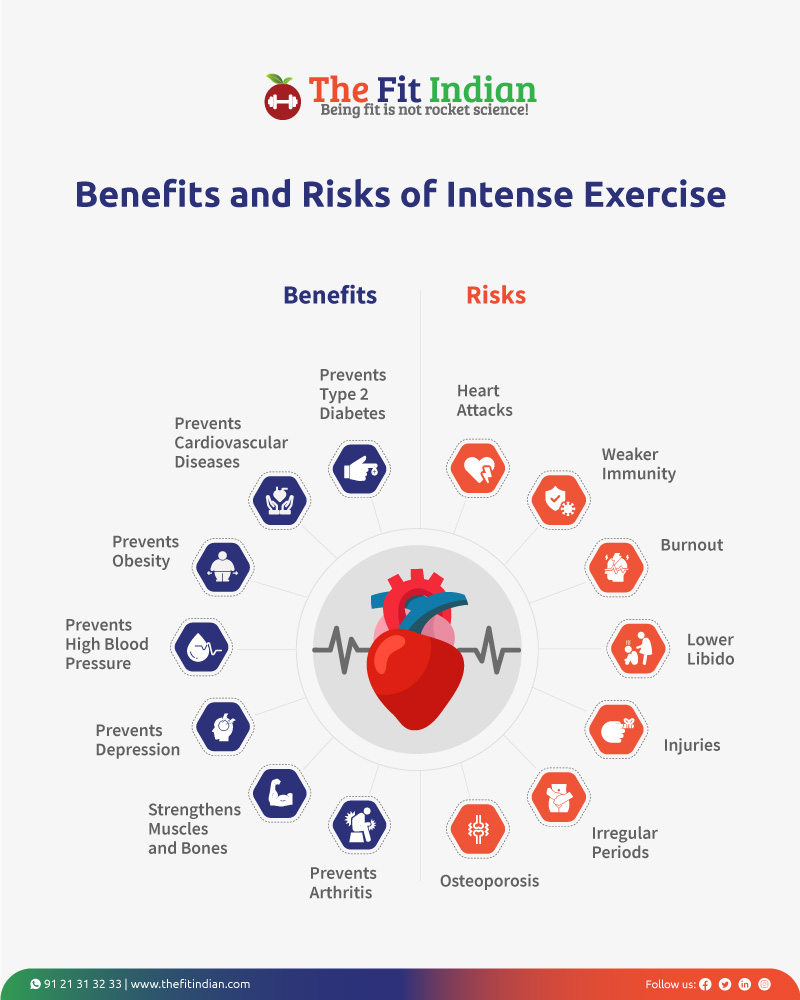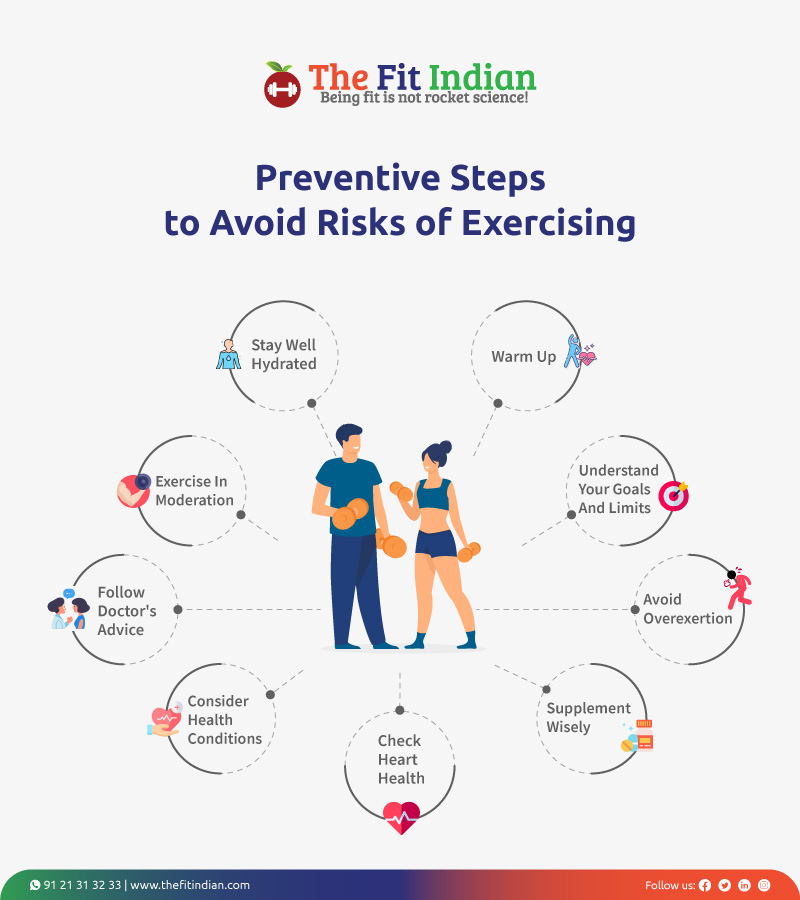How Intense Workouts Can Kill You – Heart Attacks, Risks Associated with Over Exercising
| Author: Manoja Kalakanti
Exercise is good, we all know that. In fact, it’s been constantly reiterated by our parents and elders. With the advent of social media, a slew of fitness experts has also joined the chorus, propagating the age-old natural remedy to all illnesses. So, it sounds ironic when people say that exercise leads to health problems and even death. But it is not merely working out that is resulting in deaths, but the extreme workouts that have become a trend. In this article, we’ll talk about heart attacks and other risks associated with high-intensity exercise.

A spate of heart attacks and deaths among presumably fit youngsters, and middle-aged athletes and celebrities have shattered the notion of associating fitness level with extreme endurance training. The latest fad is backed by the fallacy that intensity is the key and exercising to your maximum capacity is a must to be at the peak of health. Being out of breath by the end of your session is often the goal of fitness enthusiasts.
The gym culture has taken hold of the fitness freaks around the world. Gym selfies and posting workout videos on social media are in vogue. This is not something to be frowned upon on its own, but this behaviour often couples with addiction to exercise and unrealistic goals, which tend to backfire.
Whilst the buzz around the deaths of young people in their late twenties to mid-thirties has sounded alarm bells, does this change our perception around exercise? Yes, the cloak of invisibility around the ill effects of high-intensity exercise has come off. And the importance of moderation has once again been underlined. Just as in all other aspects of life, moderation is the golden rule one must abide by.
There is no dearth in the types of exercise you can engage in; the only thing you must beware of is how much will you be doing. You must exercise for heart health and optimal health. But it is essential to draw a line and not over-exert yourself. This article does not intend to fuel the panic surrounding the recent events of death among young and healthy people while working out. We aim at promoting the ideal way of becoming fit and healthy and offer safety guidelines for a healthy and safe workout. Let us now look at the benefits and disadvantages of exercise.
Are You at Risk of a Heart Attack?
Current events have raised an array of questions concerning workouts. There is no argument against the benefits of exercise if done correctly. But what about the rising number of deaths amongst gym rats? Are you too at risk of suffering a heart attack while pumping those weights or piling up the miles on the treadmill? How can you even tell if you stand a chance of suffering the same fate as those who succumbed to the demands of an intense workout? To answer the above questions:
- The recent deaths could be attributed to more than one factor. But intense workout does play a key role here.
- Every individual’s body, health, and needs differ. Consult with your doctor and get a thorough health check-up done before starting any new intense fitness training.
- Exercise in moderation to reduce the risks of working out.
Heavy exercise routines, which were touted as the ultimate road to superhuman fitness, have now come under the lens of scrutiny. When done at home, these workouts tend to turn more sinister by following fitness experts who lack the medical expertise to guide people safely.

COVID-19 has caused a whole new challenge. People are spending more time at home, with many working remotely. Many have signed up for online fitness classes to keep fit and ward off the coronavirus by building stronger immunity. While this is an encouraging sign that shows a greater awareness of fitness, it can also have its fair share of drawbacks. For one, many of these fitness experts do not have the necessary qualification to guide everyone. The chances of mistakes and injuries also rise exponentially due to a lack of supervision. Working out is beneficial for your health as long as you do not engage in extreme exercise.
The Benefits of Exercise
Exercise prevents several health conditions and improves your overall health. It can improve your quality of life and make you mentally and physically fit to perform day-to-day tasks at your full potential. It also improves life expectancy.
- Prevents Type 2 diabetes
- Prevents Cardiovascular diseases
- Prevents Obesity
- Prevents High blood pressure
- Prevents Depression
- Boosts energy
- Strengthens muscles and bones
- Improves skin health
- Improves sleep quality
- Prevents arthritis
These are some of the benefits of regular exercise. But what are the benefits of intense workouts?
Benefits of Intense Workout
There are many types of popular workouts. These are some examples of high-intensity workouts:
- Yoga
- Pilates
- Boxing
- Resistance training with weights
- Cardio
- CrossFit
- HIIT (high-intensity interval training)
These workouts are time efficient and can be done between your work, household chores, or even a meeting! Here are some of the benefits of an intense workout:
- Burns high amount of calories
- Boosts metabolic rate
- Helps in weight and fat loss
- Improves heart health
- No equipment is needed
- No dedicated space required
- Boosts endurance
- It is time-efficient
There are lots of intricacies involved in an exercise regimen. Not all fitness trainers are qualified enough to understand the demands of different individuals and even sexes. For example, slight modifications may be required when performing a task, depending on the sex of the person. So, what are the risks involved with an intense workout? Let’s find out!
Intense Workout And The Risk Factors Associated With It
They may be the trend, but doctors beg to differ. They advise against HIIT or any intense workout unless you are a professional athlete. Pushing your body beyond its natural endurance levels goes against the basic tenets of science and is not advisable.
Contrary to popular perception, studies show that people who worked out 4 times or more in a week were equally at risk of dying from stroke or heart attack as those who were physically inactive for the most part of a week. Shocking? Yes, but this once again highlights the importance of moderate exercise. The message is clear – working out a lot does not mean you are healthy.
Studies have also shown that men who worked out intensely for more than 5 hours a week were more likely to have irregular heartbeats than those who engaged in moderate physical activity.
So, what happens if you work out too much? Find out the risks of exercise.
1. Heart attacks
Moderate exercises such as walking, jogging, and swimming are considered to be highly beneficial for heart health. But the demands due to extreme workouts cause immense stress to the heart; even professional athletes’ hearts show signs of damage. The long-term effects of exercise on the cardiovascular system can be devastating if you exercise too hard. The normal heart rate of a person is around 60-100 BPM. When you engage in a regular workout, aim at 60-80% of maximum heart rate. People who smoke, have diabetes or have heart issues must go for 50%. Working out to a maximum heart rate of 70-85% is considered vigorous, while 80-85% is intense. Your age and fitness activity are directly related; modifications in the exercise routine must be made based on your age.
2. Weaker immunity
This might seem odd since exercise is linked to a stronger immune system. Research shows that the immune system is at its peak during exercise but becomes weaker for the next 3-72 hours. This makes us prone to attacks by bacteria and viruses, thus causing a higher risk of infections and diseases. But moderate exercise does improve immune strength in the long run.
3. Burnout
Fitness burnout is a side effect of overtraining. You are constantly exhausted, both mentally and physically lose interest in your fitness journey. To avoid this, switch your workouts, take time to recover, fuel yourself well with water and healthy food and relax; just take it slow.
4. Lower libido
Research shows that men who tend to overtrain end up with low sex drive. They seem too uninterested and too tired to be aroused and engage in sex.
5. Injuries to tendons, ligaments, joints
When you push yourself too hard in the gym, you put too much pressure on your joints, tendons and ligaments. Consistently training at high intensity also does not allow enough time to rest. This leads to injuries.
6. Irregular periods
Exercise-induced amenorrhea is a condition where you miss your periods due to overtraining. The hypothalamus, the part of your brain that controls your menstrual cycle, sends hormonal messages to your pituitary gland and your ovaries, which causes you to ovulate. Physical stress due to excess training may lead to interruption in this communication. When this communication breaks down, you do not ovulate, which in turn affects your periods.
7. Osteoporosis
While moderate exercise is considered to help with osteoporosis, intense exercise can worsen the condition. Women who exercise too much and do not have a healthy diet that includes vitamin D and calcium are prone to osteoporosis.
It also results in inflammatory bowel disease, irritable bowel syndrome. The verdict is simple, exercising is good, but stretching your limits or straining is not! But how much is too much?
How Much Exercise is Too Much?
The one question that troubles everyone is how much exercise is enough? How do you know if you have crossed the threshold? Sweat is good, they say; a fast-beating heart also indicates that you have had an awesome workout.

While pushing the limits may up your endurance levels and stamina, this is precisely what causes heart attacks and other problems. The safest thing to do is to do it in moderation and rely on scientific studies.
- CDC (Center for Diseases Control and Preventions) recommends 150 minutes or 5 hours of moderate exercise per week.
- This could be as low as 30 minutes each day for 5 days
- You can swim or walk, which is good for your health, but overexerting is a strict no.
The heart of people who train intensely for more than an hour a day adapts to the intense training. This causes it to get enlarged a little in the process. This is called an Athlete’s Heart. By itself, it is not dangerous but may cause heart-related problems like cardiac arrest and stroke.
Before you embark on a good high-intensity workouts session, take into account your age, heart health, requirements, and health conditions. You do not need to do the same workout intensely to stay. Try mixing up different activities every week. You can exercise at the gym for a day or two, followed by cycling, jogging, swimming or yoga, but within limits.
Below are some of the typical symptoms of overexercising. This could be a good indicator that you need to put the brakes on the extreme workout.
Symptoms of Overexercising:
- Being unable to perform exercises at the same level
- Taking longer rest periods
- Fatigue
- Depression
- Mood swings or irritability
- Trouble sleeping
- Sore muscles
- Injuries
There is another problem with the trend of extreme workouts – exercise addiction. Exercise can release neurotransmitters such as dopamine and endorphin, which are also released during drug use. A person feels the need to exercise more to experience the feeling.
Symptoms of Exercise Addiction:
- Experiencing withdrawal symptoms after a prolonged period of not exercising
- Constant desire to exercise leads to excess workout
- Having no control over the urge to exercise
- Ignoring other areas of life with a sole focus on exercise
To avoid this scenario, take breaks from workouts, limit your time at the gym, maintain a schedule and try practicing self-control.
To ensure that you keep the health risks at bay while exercising, follow these safety guidelines.
Safety Guidelines to Avoid Exercise-Related Risks
Many prominent athletes who had regular health check-ups, followed a healthy diet, exercised regularly, and stayed fit succumbed to heart attacks.

This shows the debilitating effects of high-intensity exercise on your health. But precautionary steps can still help.
1. Exercise in moderation
Avoid high-intensity gym workouts unless you are an athlete. You can be fit and healthy even with regular moderate exercise. But if you wish to push a little harder, ensure that you do not go too far too often. Do not fall prey to advertisements that promote incredibly intense workouts. They have their perks but also faults.
2. Doctor’s advice
Before starting any new exercise regimen or indulging in high-intensity exercise, consult your doctor. You can get a health check-up done, including a heart test. The doctor can give you proper guidance based on your family history and health condition.
3. Consider health conditions, genetic predisposition and other factors.
What works for others might not necessarily work for you and vice versa. Our bodies are different, and so are our needs. You must take into consideration your health condition, fitness level, family health history before engaging in high-intensity exercise. This again underlines the importance of moderate exercise, which almost anyone can do, without the fear of repercussions.
4. Check heart health
A healthy heart rate can be calculated by subtracting your age by 220. So, if you are 40 years old, your maximum heart rate should be 180 BPM (Beats per minute). Get a heart check-up done to see if you have any underlying heart conditions.
5. Choosing the right supplement
A healthy diet is always advised. There are many supplements out there and many fitness experts who promote them. There are a lot of fake supplements and some that are unnecessary. Do your research before buying a supplement.
6. Avoid overexercising
Exercising is, as you already know, a healthy practice. It will give positive results as long as you do not overdo it. Know your limits and do not work out till you almost pass out.
7. Understand your goals and limits
Each individual’s needs and requirements differ when it comes to fitness. Do not aim for unrealistic goals and avoid going beyond your body’s ability.
Exercising alone will not make you healthy. Nutritional support is vital in any fitness journey. Your health is made in the kitchen.
Nutritional Tips For Safer Exercise And Healthy Body
Nutrition provides the fuel for your workout and the post-workout recovery. It also helps in keeping you healthy overall and keeping diseases at bay.

Follow these nutritional tips for a better and safer workout:
- Get enough protein, but not too much
- Drink fluids often
- Do not exercise on an empty stomach; load your meal with complex carbohydrates
- Eat iron-rich foods like chickpeas, oysters, soybeans, spinach
- Include vitamin C rich foods like lemon, orange, amla, and bell peppers
- Have balanced pre- and post-workout meals, like peanut butter on whole-grain toast, a plain yoghurt with nuts, homemade fruit smoothie with protein powder, apple and cottage cheese slice
- Don’t forget your veggies; they are rich sources of many vitamins, minerals and antioxidants that promote overall health and reduce chronic disease risk
Eat healthily and exercise for good health. But maintain moderation in both. You can consult a nutritionist if you need a customized diet plan.
Bottomline
The bottom line doesn’t get any more obvious than this. Exercise is good for overall health, but moderation is the key. There are myriad benefits of exercising on a regular basis. It is good for your skin, mental health, strengthens joints and muscles, is good for digestion, boosts heart health, helps in weight loss, lowers the risk of type 2 diabetes, hypertension and promotes good sleep and sex drive. But overexertion can result in severe health problems and may even lead to heart attacks and death. High-intensity exercise is not suitable for everyone. A non-athlete must either avoid it or consult a doctor before starting a program. Exercise is good, and you must do it regularly; just remember – exercise to train and not to strain.
FAQ’s
1. What is high intensity workout?
Any form of cardio exercise that is performed vigorously for 10 minutes or more where your heart rate reaches 75% or more of your maximum heart rate is a high-intensity workout. During such workouts, the heart rate could reach up to 80-85% of your maximum heart rate.
2. Can gym cause a heart attack
It depends on the kind of workout. In moderation, you should be safe. But intense workouts increase the risk of cardiac arrest.
3. Can too much exercise cause heart problems?
Yes. Intense workout sessions may increase the risk of heart attacks and other health problems. Try to avoid overexertion and talk to your doctor before starting an exercise regimen.
4. How much exercise is too much?
This depends on the individual and their fitness levels and requirements. You are over-exercising if you feel too exhausted mentally and physically and face other health issues. Also, an exercise that causes your heart rate to exceed 80% of your maximum heart rate is considered to be intense. Regular high-intensity exercise can be too much.
5. Is running good for your heart and lungs?
Running offers several health benefits, including strengthening your heart and lungs. But overdoing it can cause problems for your heart.
6. How often should you do high-intensity workouts?
High-intensity workouts should not be done too often. 30-40 minutes a week is enough for good health and to avoid any risks.
7. Is high-intensity workout good for health?
A high-intensity workout is good for cardiovascular and metabolic health. It is also beneficial for weight loss and fat loss. But doing it too often can be detrimental to your health.
8. What are some of the dangers of exercise?
While exercise is excellent for your health, pushing too hard can result in health problems. Exercising too much can lead to mental and physical burnout, injuries to joints, heart attacks, and weaker immunity.
9. Can a person have a stroke from too much exercise?
Regular exercise can lower the risk of heart attack, stroke and many other conditions. But excessive exercise can increase the chances of these conditions, including stroke.
10. What kind of exercise can I do to lower my risk of stroke?
Regular moderate to high-intensity aerobic exercise can lower the risk of stroke. But ensure that you do not push your limits.




Manoja Kalakanti